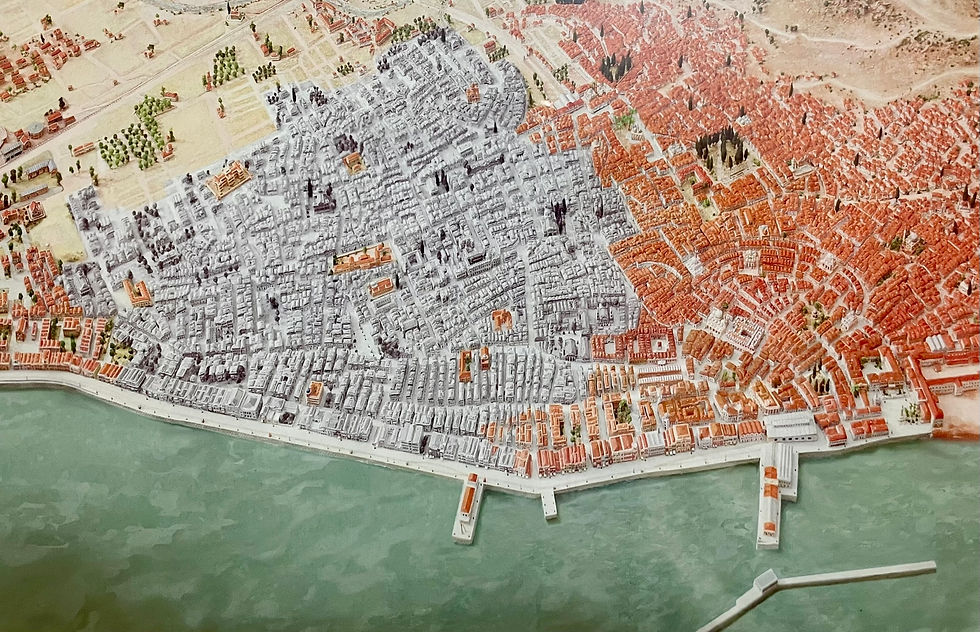Catastrophe
- Richard Crooks
- Jun 6, 2024
- 4 min read
Updated: Nov 13

Imagine, if you will, being five years old. Your father and older brother are still locked up in an internment camp. Your house has been burned down. Your mother has been crushed in the quayside throng, fallen into the water and drowned. Men are now fishing for her body with hooked poles, to try and loot any personal possession she might have been carrying.
You are effectively an orphan (as your father and brother will probably soon die of forced labour). And you are about to become a refugee, waiting for a boat to sail you to a place – an island - that you have never been to, or even heard of....
We met our first descendants of those Greek refugee son Lemnos: Maria is now a winemaker, and her grandfather was transferred from Asia Minor in the mass population exchange of 1923. Now we had just met our second, this time on Lesbos: the museum curator’s father had arrived here in Skala Loutrou that same year, aged five years old. He probably brought nothing other than the clothes he was wearing; with maybe a cherished doll or toy.

Their ancestors has been there are long time before their forced eviction: the Greek Ionians had colonised the western coast of Asia Minor in about 1,000 BC. Their Greek heritage, language and religions had survived for three millennia. Even though they had endured 700 years of Muslim Ottoman subjugation and control, they had been allowed to live on their land, speak their language, work at their profession, and worship in their Christian churches.
That would soon come to a very quick, sad and often brutal end for nearly two million ‘Greek’ inhabitants of Asia Minor. The nationalistic meltdown started as the elderly Ottoman empire waned. The still fledgling Italian nation had taken a bight out of the wounded animal in 1912. The Balkan states, including still new and youthful Greece, took more bights in 1913. And the aspiring new empire of Germany started circling the savaged beast in 1914.
The atmosphere on the ground was febrile. The Balkan Christians wanted rid of their Muslim overlords and to eradicate all traces. And not just the buildings; minor genocides ensued. The ‘Young Turks’ righty were alarmed at this persecution of their fellow men. But their response was more nationalism: “Turkey for the Turks”. Germany supported this policy as it colluded with the embryonic Anatolian republic in the 1914. "Do not trust the Greeks, they will cause you problems: a fifth column".
So, Greek men in Asian Minor were locked up or put to forced labour. Many would not survive. But they fared much better than the poor Armenians who suffered one of the largest genocides in history at the hands of the Turks.
Many neighbours that had co-existed for centuries, some of whom who read each others alphabet, and many who spoke each-others language, were now coerced to turn on each other. Muslims headed east to escape this, and Greeks headed west.
Even the armistice of 1918 (signed on the RN warship Agamemnon, anchored in Moudrous Bay on Lemnos) did not end the strife. The Greek army invaded Türkiye with their delusional ‘Big Idea’ to recapture Constantinople and their old Roman empire in Anatolia. But Mustafa Kemel (later 'Ataturk') counter-attacked and drove the Greeks back to the coast. This was the prelude to a catastrophe that would take place in the ancient city of Smyrna (now known as Izmir).

As the Greek army retreated, the Greek speaking population were soon to follow, in fear of Turkish reprisals. One of the sink ports was Smyrna, which soon became filled with 150,000 camping refugees.
There are conflicting views of who or what started the terrible fire in the Armenian quarter in September 1922. Some say it was renegade advancing Turkish soldiers. Others say it was the retreating Greek army. Maybe it was accidental? Eye-witness accounts suggest it was the former.
The reality was that high winds fanned the flames, and that many wooden houses went up like matchwood. A third of the city was destroyed and tens of thousands of people perished.


Those lucky enough to survive the flames, crowded onto the waterfront begging to be put on a ship to take them away. On the first day, there were eight ships, under U.S supervision, and then one only on each of the next six days. Any Greek who was left was told they would be dispersed into the remote Anatolian countryside. Panic ensued.
We didn’t ask our new Greek acquaintances for details about their own families’ evacuation from the west Asia Minor coast, easily visible a short distance from these islands: it seemed still too raw a subject, and still only one generation ago.
Their parents or grandparents probably moved in the more orderly migration swap on 1923, engineered by the League of Nations. This was to try and stop the random, nationalistic-fuelled carnage. But it still involved the forced displacement of over two million souls: 1.5m heading west, with the remainder heading west.
In 2022, Missy Bear’s crew visited a corner of Türkiye with a still abandoned and deserted Greek town. Now, in 2024, we were visiting islands where those people may have eventually landed and settled just a hundred years ago, to try to start new lives and new families.




Comments